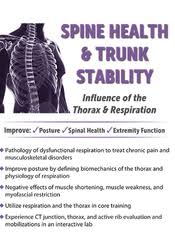Debra Dent – Spine Health, Trunk Stability
$109.00 Original price was: $109.00.$30.40Current price is: $30.40.
The thorax is a vital component of spinal function, as the center of trunk rotation. Its function is significant in shifting weight from lower extremities (LE) and upper extremities (UE) through regions of the spine.
Debra Dent – Spine Health, Trunk Stability
Clinical Observations & Implications
- Evidence-based practice and clinical observation
- Clinical implications for patient populations
- Chronic low back and SI joint pain
- Scoliosis and trunk weakness in the elderly
- Chronic hip and lateral knee pain
- Chronic cervical pain and headaches
- Shoulder impingement
- Thoracic outlet syndrome
- Fibromyalgia
- Balance and gait deviations
- Athletic performance
- Case histories — Could this be your patient?
- Chronic pain
- Marathon runner/triathlete
- Chronic low back and neck pain
Anatomy
- Respiratory and thoracic anatomy/biomechanics
- Thoracic anatomy
- Rib anatomy
- Thoracic biomechanics
- CT junction biomechanics
- TL junction biomechanics
- Trunk musculature
- Core-inner group
- Outer group
- Posterior oblique
- Deep longitudinal
- Anterior
- Lateral
- Psoas/hamstring integration
- Scalenes, SCM, C spine muscles
- Muscles of inspiration
- Muscles of expiration
- Trunk musculature
- Mechanics of respiration
- Normal breathing-mechanical effects
- Physiology of respiration
- Lung volumes
- Lung perfusion
- Hyperventilation/alkalosis
- Fascial integration
- Thorocolumbar fascia
- Lateral femoral fascia/IT band
- Abdominal fascia
- Cervical/UE and Pelvis/LE biomechanical relationships
Neuromuscular Control
- Central nervous system on muscle tone and movement
- Sympathetic and parasympathetic responses
Lab Demonstration
- Evaluation and treatment techniques
- Evaluation of posture as it relates to respiratory function, UE, pelvis and lumbar function
- Mechanics of respiration
- Diaphragmatic, lateral costal, sternal, apical breathing
- Diaphragm position
- Seated arm raise
- Seated trunk rotation
- Standing torque
- Muscle function testing
- Supine active SLR
- Prone active SLR and active arm raise
- TA, multifidus, and pelvic floor function
- Posterior oblique system
- Anterior oblique system
- Lateral system
- Rib position and mobility testing and active mobilizations
- Length testing and lengthening techniques
- Core facilitation entry training program
- Case histories evaluations, treatments, and outcomes
Theory & Evidence-Based Practice
- Suboptimal breathing patterns
- Over-inflation
- Upper chest breathing
- Diaphragm and thoracic restrictions effects on the lumbar spine/hips/LE, C spine and UE- trunk rotation, or lack of trunk rotation effects
- Posture and flawed load transference
- Trunk stability and the diaphragm/core/incontinence
- Hypertonicity/over activation of the superficial trunk muscle
- Chronic low back and SI joint pain with poor control
- Scoliosis and trunk weakness in the elderly
- Chronic hip and lateral knee pain
- Chronic cervical pain and headaches
- Shoulder impingement issues
- Thoracic outlet syndrome
- Fibromyalgia
- Balance and gait deviations
- Athletic performance
- Respiratory alkalosis/hyperventilation and the consequences
- Chronic fatigue, fibromyalgia, chronic pain
Would you like to receive Debra Dent – Spine Health, Trunk Stability ?
Description:
An Evidence-Based Practice Solution for Spinal Health, Stabilization, & Posture
The thorax is a vital component of spinal function, as the center of trunk rotation. Its function is significant in shifting weight from lower extremities (LE) and upper extremities (UE) through regions of the spine. It is a prime base for muscle and fascial connections that affect the cervical/ UE and lumbo/pelvic/LE regions. The diaphragm’s dual functions are in posture and respiration. Its muscular and neurological connections to the lumbar spine, abdominals, and pelvic floor, along with its ability to maintain intra-abdominal pressure, are both vital for spinal stability and functional posture.
Dysfunction of the respiratory complex, trunk muscular imbalances, muscular inhibition and weakness, myofascial restrictions, loss of axial rotation, and chronic hyperventilation all have significant effects on posture, trunk stability, chronic pain, motion, and upper and lower extremity function.
This recording improves your knowledge and skill set regarding spinal health, stabilization, and posture. Ms. Dent demonstrates the vital integration of the thorax and diaphragm into a functional spinal program for long-term, successful patient outcomes. Participants will discover how normal breathing patterns are regained and maintained for spine health and overall patient well-being. Practice these techniques in an interactive, hands-on lab and leave with the confidence to immediately implement them into practice.
Be the first to review “Debra Dent – Spine Health, Trunk Stability” Cancel reply
Related products
Health & Medical
Kate Freeman – Heart Of Releasing – Healthy Body, Beautiful Being
Health & Medical
Health & Medical
Health & Medical
Peter H Addy – Psychedelics, Hallucinogens and Entheogens – What Clinicians Need to Know
Health & Medical













Reviews
There are no reviews yet.